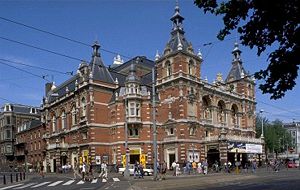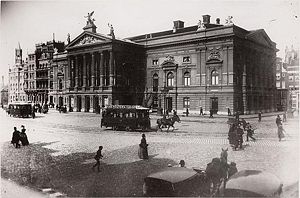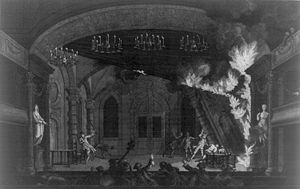
Stadsschouwburg (Amsterdam)
Encyclopedia

Leidseplein
The Leidseplein is a square in central Amsterdam, the Netherlands. Lying in the southwest of the Grachtengordel district of Amsterdam, the Leidseplein is immediately northeast of the Singelgracht canal. It is situated on the crossroads of the Weteringschans, the Marnixstraat, and the Leidsestraat...
in Amsterdam
Amsterdam
Amsterdam is the largest city and the capital of the Netherlands. The current position of Amsterdam as capital city of the Kingdom of the Netherlands is governed by the constitution of August 24, 1815 and its successors. Amsterdam has a population of 783,364 within city limits, an urban population...
in the Netherlands
Netherlands
The Netherlands is a constituent country of the Kingdom of the Netherlands, located mainly in North-West Europe and with several islands in the Caribbean. Mainland Netherlands borders the North Sea to the north and west, Belgium to the south, and Germany to the east, and shares maritime borders...
. The building is in the neo-Renaissance
Neo-Renaissance
Renaissance Revival is an all-encompassing designation that covers many 19th century architectural revival styles which were neither Grecian nor Gothic but which instead drew inspiration from a wide range of classicizing Italian modes...
style dating back to 1894, and is the former home of the National Ballet and Opera
De Nederlandse Opera
De Nederlandse Opera , in Amsterdam, is a Dutch opera company based in Amsterdam, Netherlands. Its present home base is the Het Muziektheater, a modern building designed by Cees Dam which opened in 1986....
.

The Rederijkerskamers
The first rederijkers appeared at the end of the 15th century in Amsterdam. In the 16th century, these precursors of the modern theatre organized themselves into so-called rederijkerskamers, comparable to theater companies. At that time, there were as yet no permanent theater buildings in Amsterdam, and the shipping company cherries performed on temporary stages, from carts (during processions) or in public spaces. In Amsterdam arose the Rederijkerskamers "In Liefde Bloeyende" and "'t Wit Lavendel", with the latter also known as the "Brabantsche Kamer" since its members mainly hailed from Brabant and the Flemish areas.The (Neder)duytsche Academie (1617-1637)
In 1617, the dramatists Samuel Coster and Bredero - along with their Rederijkerskamer "In Liefde Bloeyende" - founded the Duytsche Academy, an institution after the example of Italian academies, to popularize science through lectures in the national language. The Academy was established in a wooden building at Keizersgracht in Amsterdam, on the site of the modern hotel Blakes.The New Theater (1665–1772)
In 1664 it was decided that the small theater of Van Campen had to be replaced by a larger theater building more in tune with the customs and Baroque architectureBaroque architecture
Baroque architecture is a term used to describe the building style of the Baroque era, begun in late sixteenth century Italy, that took the Roman vocabulary of Renaissance architecture and used it in a new rhetorical and theatrical fashion, often to express the triumph of the Catholic Church and...
of the time. This new theater was twice as large as the old, and opened on 26 May 1665. Its first stone had been laid by the youngest daughter of the playwright Jan Vos
Jan Vos (poet)
Jan Jansz. Vos was a Dutch playwright and poet. A glassmaker by trade , he also played an important role as stage-manager and director of the theatre...
.
The Amsterdam story writer Jan Wagenaar
Jan Wagenaar
Jan Theodorus Wagenaar is a retired water polo player from The Netherlands. He finished in ninth position with the Dutch team at the 1992 Summer Olympics in Barcelona.-References:*...
gives an ample description of this building, mentioning in particular the theatre machinery, through which men could fall through the air or disappear below the stage. Gerard de Lairesse
Gerard de Lairesse
Gerard or Gérard de Lairesse was a Dutch Golden Age painter and art theorist.Lairesse was born in Liège. His broad range of talent included music, poetry, and the theatre. He was perhaps the most celebrated Dutch painter in the period following the death of Rembrandt...
helped decorate the interior.

The Hague
The Hague is the capital city of the province of South Holland in the Netherlands. With a population of 500,000 inhabitants , it is the third largest city of the Netherlands, after Amsterdam and Rotterdam...
, Utrecht
Utrecht (city)
Utrecht city and municipality is the capital and most populous city of the Dutch province of Utrecht. It is located in the eastern corner of the Randstad conurbation, and is the fourth largest city of the Netherlands with a population of 312,634 on 1 Jan 2011.Utrecht's ancient city centre features...
and on the island of Texel
Texel
Texel is a municipality and an island in the Netherlands, in the province of North Holland. It is the biggest and most populated of the Frisian Islands in the Wadden Sea, and also the westernmost of this archipelago, which extends to Denmark...
. The rubble became valuable due to the gold and the jewels in it, and the site was sold by its owners after the fire.
The First Theater on the Leidseplein (1774-1892)
The city theatre moved to the Leidseplein and opened in 1774 or 1790 with a piece by August von KotzebueAugust von Kotzebue
August Friedrich Ferdinand von Kotzebue was a German dramatist.One of Kotzebue's books was burned during the Wartburg festival in 1817. He was murdered in 1819 by Karl Ludwig Sand, a militant member of the Burschenschaften...
. The building had a wooden structure behind a stone facade. It burnt down in 1892.
The present theater on the Leidseplein (1894-today)
The present theatre replaced its burned-down predecessor. It was built between 1892 and 1894 to a design of Jan L. Springer (1850–1915), with the cooperation of his father J. B. Springer and Adolf Leonard van Gendt. In 1982 it became a RijksmonumentRijksmonument
A rijksmonument is a National Heritage Site of the Netherlands, listed by the agency Rijksdienst voor het Cultureel Erfgoed acting for the Dutch Ministry of Education, Culture and Science.-History and criteria:...
. From the end Second World War, until the opening of the Stopera
Stopera
The Stopera is a building complex in Amsterdam, The Netherlands, housing both the city hall of Amsterdam and the Muziektheater, the principal opera house in Amsterdam and the home of De Nederlandse Opera, Het Nationale Ballet, and the Holland Symfonia....
in 1986, The Netherlands Opera
De Nederlandse Opera
De Nederlandse Opera , in Amsterdam, is a Dutch opera company based in Amsterdam, Netherlands. Its present home base is the Het Muziektheater, a modern building designed by Cees Dam which opened in 1986....
was based in the Stadsschouwburg.
Culture and theatre
Whenever AFC Ajax has a major win, they often go to the steps of the cities theater to be publicly applauded. The normal programme of events encompasses all sorts of theatrical forms, mostly by Dutch writers.The Boekenbal (book ball) is traditionally held in the Stadsschouwburg and it marks the beginning of the annual Boekenweek
Boekenweek
In the Netherlands, the Boekenweek is an annual "week" of ten days dedicated to Dutch literature. It is held in March since 1932. Each Boekenweek has a theme. The beginning of the Boekenweek is marked by the Boekenbal , a gathering that is attended by writers and publishers...
(book week).

